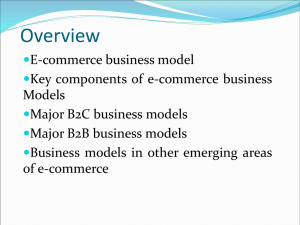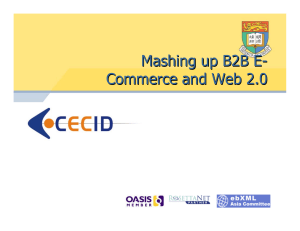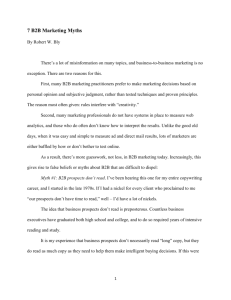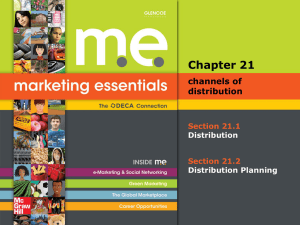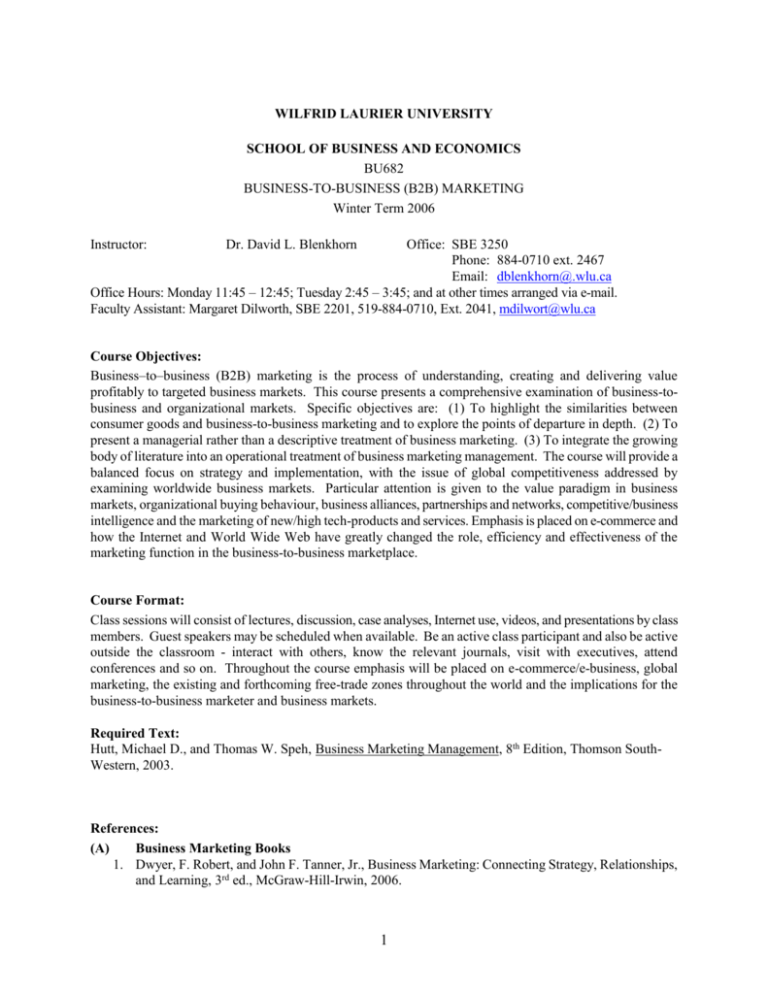
WILFRID LAURIER UNIVERSITY
SCHOOL OF BUSINESS AND ECONOMICS
BU682
BUSINESS-TO-BUSINESS (B2B) MARKETING
Winter Term 2006
Instructor:
Dr. David L. Blenkhorn
Office: SBE 3250
Phone: 884-0710 ext. 2467
Email: dblenkhorn@.wlu.ca
Office Hours: Monday 11:45 – 12:45; Tuesday 2:45 – 3:45; and at other times arranged via e-mail.
Faculty Assistant: Margaret Dilworth, SBE 2201, 519-884-0710, Ext. 2041, mdilwort@wlu.ca
Course Objectives:
Business–to–business (B2B) marketing is the process of understanding, creating and delivering value
profitably to targeted business markets. This course presents a comprehensive examination of business-tobusiness and organizational markets. Specific objectives are: (1) To highlight the similarities between
consumer goods and business-to-business marketing and to explore the points of departure in depth. (2) To
present a managerial rather than a descriptive treatment of business marketing. (3) To integrate the growing
body of literature into an operational treatment of business marketing management. The course will provide a
balanced focus on strategy and implementation, with the issue of global competitiveness addressed by
examining worldwide business markets. Particular attention is given to the value paradigm in business
markets, organizational buying behaviour, business alliances, partnerships and networks, competitive/business
intelligence and the marketing of new/high tech-products and services. Emphasis is placed on e-commerce and
how the Internet and World Wide Web have greatly changed the role, efficiency and effectiveness of the
marketing function in the business-to-business marketplace.
Course Format:
Class sessions will consist of lectures, discussion, case analyses, Internet use, videos, and presentations by class
members. Guest speakers may be scheduled when available. Be an active class participant and also be active
outside the classroom - interact with others, know the relevant journals, visit with executives, attend
conferences and so on. Throughout the course emphasis will be placed on e-commerce/e-business, global
marketing, the existing and forthcoming free-trade zones throughout the world and the implications for the
business-to-business marketer and business markets.
Required Text:
Hutt, Michael D., and Thomas W. Speh, Business Marketing Management, 8th Edition, Thomson SouthWestern, 2003.
References:
(A)
Business Marketing Books
1. Dwyer, F. Robert, and John F. Tanner, Jr., Business Marketing: Connecting Strategy, Relationships,
and Learning, 3rd ed., McGraw-Hill-Irwin, 2006.
1
2. Anderson, James C., and James A. Narus, Business Market Management, 2nd Edition, Pearson
Prentice-Hall, 2004.
3. Bingham, Frank G., Jr., Roger G. Gomes, and Patricia A. Knowles, Business Marketing, 3rd ed,
McGraw-Hill Irwin, 2005.
4. Brierty, Edward G., Robert W. Eckles and Robert R. Reeder, Business Marketing, Third Edition,
Prentice-Hall, 1998.
5. Chisnall, Peter M., Strategic Industrial Marketing, 2nd Ed., Prentice-Hall, 1989.
6. Corey, E. Raymond, Industrial Marketing: Cases and Concepts. 4th Ed., Prentice-Hall, 1991.
7. Eckles, Robert W., Business Marketing Management, Prentice-Hall, 1990.
8. Gross, Andrew C., Peter M. Banting, Lindsay N. Meredith, I. David Ford, Business Marketing.
Houghton Mifflin, 1993.
9. Haas, Robert W., Business Marketing Management, 5th Ed. PWS-Kent, 1992.
10. Hayes, H. Michael, Per V. Jenster and Nils-Erik Aaby, Business Marketing: A Global
Perspective, Irwin, 1996.
11. Mahin, Philip W., Business-to-Business Marketing, Allyn and Bacon, 1991.
12. Morris, Michael H., Industrial and Organizational Marketing. Macmillan, 1992.
13. Powers, Thomas L., Modern Business Marketing. West, 1991.
14. Rangan, V. Kasturi, Benson P. Shapiro, and Rowland T. Moriarty, Jr., Business Marketing, Irwin,
1995.
15. Webster, Frederick E. Jr., and Yoram Wind., Organizational Buyer Behaviour. Prentice-Hall,
1972.
(B)
1.
2.
3.
4.
Business Marketing Journals
The Journal of Business and Industrial Marketing
(an academic journal oriented toward practitioners)
Business Marketing (a trade journal for practitioners)
Industrial Marketing Management (an academic journal)
Journal of Business-to-Business Marketing (an academic journal)
Student Evaluation:
Group project
Mid-term exam
Final exam
30%
30%
40%
100%
It is expected that students will attend all class sessions.
Course Requirements:
THE GROUP PROJECT
(due beginning of class April 3)
Group Project: Industry and Rival Firm B2B Strategic Analysis
Objectives:
1. To enable your group to compare and contrast two B2B firms which are competing for the same
customer groups.
2
To enable your group to perform a consultant’s role and produce a value-added report for your
“client” firm.
3. To enable your group to present and defend your findings to the rest of the class.
2.
The project: an overview: In groups of 4-5 students, select an industry of your choice, and within that
industry select two firms to research. The industries and firms that we address in cases in this course are
not eligible for study in this project. Your group has been hired by one of the two rival firms as
consultants to research the industry, its principal competitor, as well as itself. Choose two firms that
compete for the same customers in the same industry and one of them becomes your client. This firm has
given your group some leeway in your research and report, but as a minimum, it wants the following
questions/issues addressed:
1. Just where is our industry headed in the future? Suggested time horizons are: 1 year, 5 years, 10
years, 15 years. You must address issues such as: Will there be any major new developments in
our industry? If so, when will they occur, and how will they impact us and on our major rival?
Where will the future competition come from?
2. Are there any new B2B marketing concepts, techniques, and methodologies pertinent to our
industry of which we should be aware?
3. What is the position of our major rival vis-à-vis us? Now and in the future. What are the
timeframes?
4. What future strategies is our major rival contemplating? When are these strategies likely to come
into effect? Given these future strategies, what should we do? When?
In summary, what your client firm really wants from your group is actionable advice that it will utilize as input
as it prepares its strategic marketing direction for the future, as well as the recommended tactics it should use.
Your recommendations should be able to be implemented, and in so doing, consider timing, resource
allocations, responsibility areas, sequencing, and contingency arrangements. These are things that senior B2B
marketing decision-makers must deal with and want to trust that their B2B consultants (your group) have
thoroughly considered.
Other things to consider about the project:
1. If you select large companies to research, focus your analysis on a specific division or strategic
group within each firm, so you will be researching similar customer groups
2. The Economist, The Wall Street Journal, Business Week, Forbes, Fortune, Globe and Mail Report
on Business, Financial Post, etc., are good places to start.
3. You are advised to select a global industry and two large firms within that industry, as there will
be a richer selection of data/information to choose from in going this route.
4. As soon as your group has done substantive work on the project, you should meet with me so we
can discuss your progress and address any concerns/issues that have arisen that may benefit from
my input.
The Written Report:
The paper should not exceed 15 pages, including exhibits. Text should be double-spaced, using a 12-point
font and one-inch margins. Exhibits in the form of tables, diagrams, figures, illustrations, models,
footnotes, references, etc., can and should be added. Of course, you will also want to include an executive
summary and table of contents to facilitate the reader’s task. The paper should be of the highest
professional quality and one you would be proud to provide to a potential (or current) employer as
indicative of the superior quality of your efforts in the MBA program.
3
Report Evaluation Criteria:
The ensuing general guidelines will be followed for the purposes of grading papers. Although each item will be
assessed, their weight will not necessarily be identical. All are important and will be included in the grade. I have
divided these items into content and presentation sections below.
Content elements:
1. Thoroughness of research. Although a group might ultimately rely mostly upon a few primary sources, I
expect you to have done a comprehensive review of the available information available with respect to your
project. Examples of data sources you should consider reviewing include: interviews with organizational officials,
electronic databases, annual reports, company-provided publications or press releases, internet-based/WWW sites,
academic studies or cases, business journals, specialized trade journals, legal and government documents. You
should thoroughly document the sources you reviewed in your references section. Those sources that provided
information that you actually included in your report will be noted via endnotes.
2. Soundness of analysis. I expect the analysis to be both logical and based on the "facts" as best you were able to
determine them. It is also critical to use as many of the tools and techniques we have covered during the term and
to also use methods from other courses or real-world experiences as appropriate. This requirement suggests
consulting with the professor when necessary as he can potentially identify and point out information sources
about methods that can assist you in successfully completing your group's effort.
3. Practicality of paper. This will assess how well your report met the requirements of the project. You
should develop useful analysis and recommendations that, at a minimum, achieve the following: insightful,
realistic, based on reasonable assumptions, not lacking to identify any critical interrelationships, resourceeffective, feasible/possible, etc.
Written Presentation elements:
5. Style and format. I expect the papers to be highly readable and organized. Among other things, this means that
your group’s paper should be logically organized, grammatically correct, spell-checked, look visually appealing,
have properly cited sources, and use formats besides plain text when appropriate to communicate important ideas.
The output should be of the highest quality. Your grade will be reduced if I cannot understand your paper, it is
"sloppy" or unprofessional.
6. Followed Directions. This means whether your group turned the project in at the prescribed date/time and
whether you did all the items as stipulated in these directions.
Your fellow classmates will give your group instant feedback on how well they think you did in your efforts.
CLASS SCHEDULE AND READING ASSIGNMENTS
Session 1
(Jan.9)
(1) Course Introduction
(2) Ethics in B2B Marketing
Read:
(1) Case #15 (in-class handout)
(2) Argandona, Antonio, “On Ethical, Social, and Environmental
Management Systems”, Journal of Business Ethics, April, 2004, 51(1),
41-52. (course CD)
Session 2
(Jan. 16)
(1) The B2B Marketing Environment
(2) The Global Dimension in B2B Marketing
4
Read: (1) Chapters 1, 2, 10
(2) Holland, Christopher P., and Pete Naudé, “The metamorphosis of
marketing into an information-handling problem”, Journal of Business &
Industrial Marketing, 2004, 19(3), 167-177. (course CD)
(3) Cavusgil, S. Tamer, Segun Yeniyurt, and Janell D. Townsend, “The
framework of a global company: A conceptualization and preliminary
evaluation”, Industrial Marketing Management, 2004, 33(8), 711-716.
(course CD)
(4) Case #4, Westward Industries (A) (P. 522)
Discussion Questions:
(1)
What are the principal distinguishing characteristics between
business and consumer marketing? How critical are they to the
success of the business marketer?
(2)
How important is the concept of derived demand to the business
marketer?
(3)
What are some of the implications if the business marketer
doesn’t fully understand the complete product/service value
chain?
(4)
What is the role of competition and co-operation in business
markets today? (You may want to take a specific industry as an
example.)
(5)
How does the business marketer’s strategy differ when dealing
with: (a) commercial enterprises (2) governments (3) other
organizations?
(6)
Are these 3 mutually exclusive from the business marketer’s
perspective?
(7)
How does the global dimension affect the business marketing
function? What are the key things to consider? What is likely to
occur if these things are neglected?
(8)
What are the principal drivers of globalization?
(9)
What is the relationship between global business marketing and
the global environmental (green) movement? What is the
significance of the conferences in Rio de Janeiro, Kyoto, Buenos
Aires, and The Hague?
(10)
Discuss the globalization of business markets and the value chain.
(11)
Identify changes in technology that are currently having a
significant impact on business marketing practices and/or
will do so in the future. Discuss the likely consequences if
the business marketer doesn’t embrace these new
technologies.
Case Questions:
(1)
In what business is Westward Industries Ltd. (WIL)?
(2)
Critically evaluate WIL’s operations to date, especially their
experience with the GO-4.
(3)
Assess Cushman’s strategy to date.
(4)
Propose a future strategy for WIL and the GO-4.
5
Session 3
(Jan. 23)
Why and How Customers Buy – Organizational Buying Behavior
Read: (1) Chapter 3
(2) MacDonald, Jason B., and Kirk Smith, “The effects of technologymediated communication on industrial buyer behaviour”, Industrial
Marketing Management, 2004, 33(2), 107-116. (course CD)
(3) Case #2, S.C. Johnson’s Professional Division (P. 513)
Discussion Questions:
(1)
What are some of the current purchasing trends of which the
business marketer should be cognizant? For each one cited,
explain the implications for the business marketer.
(2)
Explain total cost of ownership, value analysis, and other forms
of purchase evaluation.
(3)
How does government purchasing differ from corporate
purchasing? What are the implications for the business marketer?
(4)
What are the key points in customer buying processes?
(5)
How does business buying behavior differ from consumer buying
behavior?
(6)
What are the principal models to follow in understanding
business buying behavior? How relevant are they for the new
millennium?
(7)
How could a marketer of high-tech business communications
products and services (e.g. Bell, ATT&T, etc.) utilize the Buygrid
Framework?
(8)
How might Bombardier identify the buying centre of potential
purchasers of its corporate jets? Of what use is this information?
Case questions:
(1)
In purchasing cleaning products and services, which of the
following managers might be members of the buying centre at a
discount retailer like Wal-Mart or Zeller’s: a purchasing executive
at the headquarters level, store managers, a merchandising
executive, a marketing manager, a maintenance staff supervisor, or
maintenance employees? Who would be most influential in the
buying decision?
(2)
Describe how the evaluative criteria employed by the
purchasing manager might be different from those that are
important to users.
(3)
Explore how the needs of a health care organization might differ
from the needs of a retailer in purchasing cleaning products and
services.
Session 4
(Jan. 30)
Formulating and Managing B2B Relationships
Read: (1) Chapter 4
(2) Svensson, Goran, “Vulnerability in business relationships: the gap
between dependence and trust”, Journal of Business and Industrial
Marketing, 2004, 19(7), 469-483. (course CD)
(3) Deeter-Schmelz, Dawn R., and Karen Norman Kennedy, “Buyer-
6
seller relationships and information sources in an e-commerce world”,
Journal of Business and Industrial Marketing, 2004, 19(3), 188-196.
(course CD)
(4) Zablah, Alex R., Danny N. Bellenger, and Wesley J. Johnson, “An
evaluation of divergent perspectives on customer relationship
management: Towards a common understanding of an emerging
phenomenon”, Industrial Marketing Management, 2004, 33(6), 475-489.
(course CD)
(5) Case #3, Southwestern Ohio Steel Company, L.P: The Matworks
Decision (P. 515)
Discussion Questions:
(1)
Describe and explain the significance of the various types of buyerseller relationships found in business markets. What is the effect of
e-business on these relationships (e.g., online markets)?
(2)
Explain the various relationship connectors that are used in different
types of buyer-seller relationships.
(3)
Explain several procedures for designing effective relationship
marketing strategies.
(4)
What are the critical determinants of success in managing B2B
relationships (e.g., partnerships, strategic alliances, etc.)?
Case questions:
(1)
Critically evaluate Matworks’ request for SOSLP to participate in “a
unique marketing opportunity to solidify relations with Matworks”.
(2)
Why is Dan Wilson concerned about Matworks’ request?
(3)
What should Dan Wilson do? Elaborate.
(4)
Give guidelines for B2B firms to follow in managing external
relationships.
Session 5
(Feb. 6)
E-Commerce Strategies
Read: (1) Chapter 5
(2) Ryssel, Ricky, Thomas Ritter, and Han Georg Gemünden, “The impact
of information technology deployment on trust, commitment, and value
creation in business relationships”, Journal of Business & Industrial
Marketing, 2004, 19(3), 197-207. (course CD)
(3) Case #1, Cisco Systems (P. 487; do a web search for an update on Cisco
Systems; visit their website)
Discussion Questions:
(1)
What is the nature of e-commerce in business markets? Give
examples.
(2)
What role should e-commerce play in firms’ B2B marketing
strategy?
(3)
Compare and contrast the general lack of success of e-tailing with ebusiness in B2B markets? What can B2B or B2G learn from the
B2C failures?
(4)
What advice would you give to a B2B firm that wanted to embrace
e-commerce?
7
(5)
What do you see as the future for B2B e-commerce?
Case questions:
(1)
Give an overview of Cisco’s e-commerce strategy as outlined in the
case and from visiting their website.
(2)
Critically evaluate Cisco’s e-commerce strategy.
(3)
How applicable is Cisco’s e-commerce strategy to B2B markets in
general?
(4)
What e-commerce lessons can be learned from the case?
Session 6
(Feb. 13)
(1) Mid-term Exam
(2) Supply Chain Management
(3) Channels in Business Markets
Read: (1) Chapters 6, 14
(2) Eng, Tack-Yong, “The role of e-marketplaces in supply chain
management”, Industrial Marketing Management, 2004, 33(2), 97-105.
(course CD)
(3) Case #1, Cisco Systems (P. 487) (revisited)
Discussion Questions:
(1)
What is meant by business marketing channel strategy?
(2)
What criteria are important when determining channel strategy?
(3)
What is the impact of technology on channel strategy?
(4)
How does the global dimension affect channel strategy?
(5)
Analyze customer needs for channel service outputs.
(6)
Discuss the challenges of managing channel relationships and
coordinating activities across organizational boundaries.
(7)
Describe various relationship forms in channels. What is the
significance of the different forms to the business marketer?
(8)
Explain the role of supply chain management in B2B marketing
strategy.
(9)
Justify the importance of integrating both firms and functions
throughout the entire supply chain.
(10)
Critique the following: “In the future we will see the primary battles
in B2B take place as supply chain networks compete against other
supply chain networks.” Is this happening today? Explain.
(11)
Explain the importance of achieving high levels of logistics service
performance while simultaneously controlling the cost of logistics
activities. Give examples, where possible.
(12)
Explain the role of e-marketplaces in SCM
Case questions:
(1)
Cisco learned early on that it would not use Internet commerce
applications to lessen its reliance on channel partners and resellers.
Was that an appropriate decision? Who has been best served by
Cisco’s strategy? How can or should Internet commerce change
relationships with your partners?
8
(2)
(3)
(4)
Session 7
Give an overview of Cisco’s supply chain management strategy
gleaned from the case, from visiting their website, and from other
sources.
Critique the effect of CCO on Cisco’s supply chain management
strategy.
How could CCO be enhanced to improve Cisco’s supply chain
management?
Identifying and Assessing Market Opportunities
(Feb. 27)
Read: (1) Chapters 7, 8
(2) Lockett, Andy, and Ian Blackman, “Conducting market research using
the Internet: the case of Xenon Laboratories”, Journal of Business and
Industrial Marketing, 2004, 19(3), 178-187. (course CD)
(3) Palmer, R.A., and P. Millier, “Segmentation: Identification, intuition,
and implementation”, Industrial Marketing Management, 2004, 33 (8),
779-785. (course CD)
(4) Case #10, Wind Technology (P. 617)
Discussion Questions:
(1)
What are some methods of maximizing the value of current
customers?
(2)
Outline the basic structure and capabilities of a customer
database.
(3)
Describe some methods of conducting customer research.
Critique them.
(4)
Illustrate how suppliers and customers can collaborate to find
opportunities.
(5
Describe various methods of segmenting business markets.
Critique the methods.
(6)
Explain methods to evaluate the potential of market segments
Case questions:
(1)
What key criteria should be considered in segmenting the HVPS
market?
(2)
From the information in the case, prepare a segmentation
framework, followed by a recommended targeting and positioning
strategy. Justify your recommendations.
(3)
From the list of promotion options given on pages 621-623 (given
the corporate realities of Wind Technology), what promotion
strategy(ies) do you recommend to reach your selected segment(s)?
Session 8
(March 6)
(1) Managing Products for Business Markets
(2) Managing Innovation & New Product Development
(3) Managing Services for Business Markets
Read: (1)Chapters 11, 12, 13
(2) Tzokas, Nickolaos, Erik Jan Hultink, and Susan Hart, “Navigating the
new product development process”, Industrial Marketing Management,
2004, 33 (7), 619-626. (course CD)
9
(3) Case #14, Advanced Elastomer Systems (P. 662)
Discussion Questions:
(1)
How can portfolio and product life cycle concepts be applied to
managing existing products/services?
(2)
Describe and critically evaluate various methods of developing
products/services internally.
(3)
Discuss the importance of lead users to the product/service
development process.
(4)
Indicate what partnering with suppliers and customers means to
the product/service development process.
(5)
What is the relationship between a firm’s core competencies and
its product and service strategies?
(6)
What are the essentials of a sound product policy?
(7)
Why is a sound new product strategy important?
(8)
What are the criteria that distinguish high performing
new/high technology companies?
(9)
Explain Quality Function Deployment (QFD). How is it related
to new product strategy?
(10)
What are the key determinants of new product success and
failure?
Case questions:
(1)
Assess the market strategy options for the new soft-touch product
as outlined in the case beginning on page 679. Is there a better
option(s) you would recommend?
(2)
Choose your optimal recommended option from Q. #1 above, and
give your marketing strategy for this option.
(3)
Does the case parallel or reinforce the theory you have read about
new product strategy? Elaborate.
Session 9
(March 13)
Pricing Strategies in Business Markets
Read: (1) Chapter 15
(2) Hinterhuber, Andreas, “Towards value-based pricing – An integrative
framework for decision making”, Industrial Marketing Management,
2004, 33 (8), 765-778. (course CD)
(3) Case #11, Augustine Medical, Inc. (P. 624)
Discussion Questions:
(1)
Identify some of today’s pricing pitfalls in business marketing.
(2)
Explain the key interest groups in the pricing decision.
(3)
Discuss the effect of the following on a firm’s pricing
strategies: costs, demand, competitors, channel coordination
and regulations.
(4)
What principles of conflict management can best be utilized
in price negotiation?
(5)
What is the relationship between economic theory and pricing?
(6)
What are the most important criteria the seller should
consider when setting price?
(7)
What is the relationship between PLC and pricing?
10
(8)
(9)
(10)
What are the most important criteria that buyers consider about
price?
Are there any guidelines which you would recommend
following when involved in the bidding process?
How does the global dimension affect pricing?
Case questions:
(1)
How would you characterize the prevailing technologies and
products for preventing and treating postoperative hypothermia?
(2)
What factors will influence the market potential for the Bair
Hugger Patient Warming System?
(3)
What should be the pricing objectives and strategies for The Bair
Hugger Patient Warming System?
(4)
What list price to hospitals should Augustine Medical set for The
Bair Hugger Patient Warming System and what short-run profit
impact can be expected from this decision?
(5)
What should be the list price for the heater/blower unit? A
variety of prices are possible, ranging from nothing (“Give it
away!”) to just under $1500 (to overcome hospital buying
committee approval), to $4,000 to be price competitive with the
Climator, to $6,000 (“Let’s skim the market given our innovative
technology!”).
Session 10
(March 20)
(1) Integrated Marketing Communications
(2) Managing the Personal Selling Function
Read: (1) Chapters 16, 17
(2) Chaisrakeo, Sunanta, and Mark Speece, “Culture, intercultural
communication competence, and sales negotiation: a qualitative research
approach”, Journal of Business and Industrial Marketing, 2004, 19(4),
267-282. (course CD)
(3) Case #14, Advanced Elastomer Systems (P. 662) (revisited)
Discussion Questions:
(1)
What is the nature of communication and dialogue in the B2B
marketplace?
(2)
How would communication strategy vary depending upon the
application of buying theory and market position?
(3)
What are the key things to consider when determining the
communications strategy of an industrial firm?
(4)
What is the role of electronic technology (e.g., Internet, Intranet,
Extranet, EDI, etc.) in an industrial organization’s
communication strategy? How should the marketer manage
technology (e-commerce) in the communication mix/strategy?
(5)
Contrast the role of advertising in consumer and business
organizations. Are there any guidelines to follow?
(6)
What are the roles of publicity and public relations in an
industrial organization’s communication strategy?
(7)
How can business advertising effectiveness be measured?
(8)
Give, with justification, some media selection criteria for business
11
(9)
(10)
(11)
(12)
(13)
(14)
(15)
(16)
(17)
(18)
(19)
marketing communication.
What guidelines would you give to develop goals and a strategy
for trade shows?
Give guidelines for the utilization of one-to-one media.
What is the role of personal selling in the firm’s communications
mix?
How does personal selling fit in with the relationship marketing
paradigm? Are the two terms synonymous?
What are the key points to consider when planning your
salesforce? Are some criteria more important than others?
Elaborate.
What are the various ways of organizing your salesforce? When
would you use each method? Are they mutually exclusive?
Illustrate when to use different control and compensation
programs.
What is the impact of information technology (e.g., EDI, email,
fax, Internet, Intranet, Extranet, PCS, etc.) on the personal
selling function?
What is “relationship quality”? What is the salesperson’s role in
it?
Explain “key account management/national account
management”. Give examples where they would be used.
Explain the different types of selling used for different
types of relationships.
Case question:
(1)
Select one of the options outlined in the case beginning on page
679 and prepare an integrated marketing communications plan
for this option.
Session 11
(March 27)
(1) Formulating and Implementing Business Marketing Strategy
(2) Controlling B2B Strategies
Read: (1) Chapters 9, 18
(2) Flint, Daniel, J., “Strategic marketing in global supply chain
management: Four challenges”, Industrial Marketing Management, 2004,
33(1), 45-50. (course CD)
(3) Case #13, Ace Technical (P.647)
Discussion Questions:
(1)
Describe the key elements of a business strategy.
(2)
Conduct a SWOT analysis of an organization with which you are
familiar.
(3)
Analyze the structure of competition, considering Porter’s Five
Forces model.
(4)
Give examples of the fleeting nature of competitive advantage.
(5)
Outline firm characteristics that should enable learning and the
creation of dynamic strategies.
(6)
Describe the role marketing plays in creating and maintaining a
learning organization.
12
(7)
(8)
(9)
(10)
(11)
(12)
(13)
Describe the internal partnerships that must be developed with
marketing.
Illustrate the partnering process for various internal partnerships.
List the skills that are needed by marketing managers to build
internal partnerships.
Describe the importance and dimensions of control
systems.
Explain various control tools and situations where they are best
utilized.
Explain tolerance ranges for marketing performance.
Describe how control processes contribute to other
organizational processes such as reengineering and
strategic planning
Case Question:
(1) See the last paragraph on page 661.
Session 12
(April 3)
(1) Course Summary
(2) Group Project Presentations
13
GROUP PROJECT PROPOSAL
BUSINESS MARKETING MANAGEMENT
Group Members: (give e-mail of contact person)
1.
3.
2.
4. __________
5.___________
INDUSTRY/COMPANIES:______________________________________________________________________
__________________________________________________________________________________________
FOCUS OF
STUDY:_____________________________________________________________________________________
____________________________________________________________________________________________
____________________________________________________________________________________________
____________________________________________________________________________________________
VERIFIED SOURCES OF INFORMATION NEEDED FOR STUDY:
______________________________________________________________________________
______________________________________________________________________________
______________________________________________________________________________
______________________________________________________________________________
______________________________________________________________________________
______________________________________________________________________________
______________________________________________________________________________
______________________________________________________________________________
______________________________________________________________________________
______________________________________________________________________________
______________________________________________________________________________
______________________________________________________________________________
______________________________________________________________________________
______________________________________________________________________________
APPROVED
YES
NO
PROFESSOR’S COMMENTS:
______________________________________________________________________________
______________________________________________________________________________
______________________________________________________________________________
______________________________________________________________________________
______________________________________________________________________________
14
Name: _______________________________________________Course:____________
EVALUATION OF GROUP MEMBERS’ CONTRIBUTIONS
ON A SCALE OF 1 TO 10 RATE EACH MEMBER’S CONTRIBUTION TO THE GROUP PROJECT ON THE FOLLOWING CRITERIA
SELF
1.
Contributed a lot of
creative ideas that were
useful for the project
2.
Provided leadership, helped
the group organize, kept
the group moving along on
task.
3.
Did a lot of the research.
4.
Helped a lot with the
mechanics of putting the
report together.
5.
Attended group meetings
and those with the client
firm regularly. (if
applicable)
NAME
SUB TOTAL POINTS
6.
If you were the head of a
department and had
$10,000 in total to
distribute to your group
members as a bonus for the
overall quality of their
contribution to the project,
how much would you
allocate to each? (include
yourself)
15
NAME
NAME
NAME



